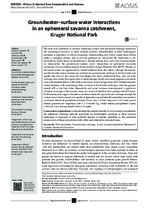Groundwater–surface water interactions in an ephemeral savanna catchment, Kruger National Park

View/
Date
2020Author
Nel, Jacobus M.
Riddell, Edward Sebastian
Van Tol, Johan J.
Metadata
Show full item recordAbstract
The semi-arid conditions in savanna landscapes ensure that ephemeral drainage dominates the hydrological network in these dryland systems. Quantification of their hydrological processes is important to inform ecosystem understanding and future conservation efforts under a changing climate, and to provide guidance for restoration. By combining in situ hydrometric observations, hydrochemistry, remote sensing and a soil water balance model, we characterise the groundwater–surface water interactions in ephemeral low-order catchments of the granitoid regions of the southern Kruger National Park (KNP). Streams at the lowest orders are augmented by lateral interflows from the catena, although the second-and third-order stream reaches are conduits for groundwater recharge to the fractured rock aquifer; the soils of the crests and foot-slopes also show preferential flow, and are truly recharge soils, whilst the duplex soils of the midslopes clearly show their responsive nature to a low soil moisture deficit in the shallow horizons. Actual evaporation (aET) differed between catena elements with surprisingly little variation at third-order hillslopes, with the greatest overall aET at the first order. Meanwhile, soil water balances demonstrated a significant variation in storage of the riparian zones as a result of interflow from upslope and aET losses. Furthermore, data support broader-scale observations that groundwater recharge through the vadose zone to the fractured rock aquifer is dependent upon threshold antecedent precipitation conditions. Moderate precipitation events (5 mm/day – 35 mm/day) over a 2–3 week period initiate groundwater responses with a 2–3 month lag, whilst intense precipitation events (>100 mm/day) are expressed within 2–3 weeks.
